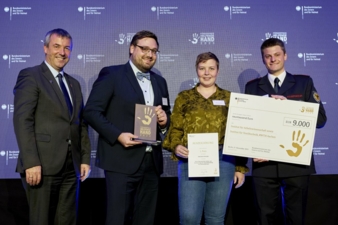01.12.23 – RWTH Aachen
Better protection for female firefighters
Firefighter protective clothing for women does not fit well - the clothing is primarily designed for men and is often too wide at the shoulders, too tight on the upper body and too long on the arms and legs. Women firefighters have less confidence in their protective clothing and a higher risk of accidents.
The Institute of Human Factors (IAW) and the Institut für Textiltechnik (ITA) of RWTH Aachen University have identified this problem and were awarded the Federal Ministry of the Interior´s (BMI) Helping Hand Award on 27th November 2023, the highest award in Germany for voluntary work. Last Monday, the Parliamentary State Secretary of the BMI, Johann Saathoff, honoured the doctoral students Carsten Schiffer (IAW), Rahel Heesemann (ITA) and Justin Kühn (ITA) on behalf of the entire team, along with 15 other projects. The team behind the project “This path will not be easy - improving protective clothing for female firefighters" was able to beat 63 other applicants in the "Innovative concepts” category. The proportion of women in the fire service is around 10%, as of December 2020, and the trend is rising. The relative accident risk for women is twice as high, according to a scientific article by Carsten Schiffer from 2023.
In addition, the analysis of accident reports shows that women have more frequent and more serious accidents than their male colleagues. “You can't directly deduce the cause of an accident from poorly fitting firefighter clothing,” says Carsten Schiffer from the IAW. “But when I look at the accident reports and see the injuries that occur, it´s obvious that it´s at least partly to do with the ill-fitting protective clothing.” It seems likely, for example, that more tripping injuries among women are due to trouser legs that are too long or ill-fitting boots. Firefighter clothing must fulfil many requirements: it must protect against fire, chemicals and more, must not tear, should transport sweat to the outside, but keep the heat outside. The inner lining ensures comfort and protects against injuries. However, women trust their protective clothing less, as an interview study by Carsten Schiffer shows, presumably because the protective clothing does not fit properly. This is a sensitive issue: a good fit means that there must be exactly the right distance between the skin and the inner lining of the firefighter´s protective clothing. Exactly the right distance is about two centimetres - a thumb´s width. If the clothing is not adapted to the wearer´s body shape, the protective effect can be impaired. “In general, we need all the helping hands in the fire service,” says Rahel Heesemann from the ITA. “The minimum requirement is that the protective clothing fits well.”
How did the collaboration between the IAW and ITA come about?
Carsten Schiffer is a Bachelor´s graduate of Rahel Heesemann and Justin Kühn and worked on this topic in his Bachelor's thesis. He originally wanted to look at the more ecological design of protective clothing for firefighters. Members of the fire service cited the ergonomics of protective clothing as a more pressing problem. Carsten Schiffer changed his topic accordingly and pursued it further in his master´s thesis at the IAW and now as a doctoral student. Now both chairs want to pursue the approach of ergonomically adapting firefighter protective clothing to women's bodies, among other things, together with industry partners and have submitted a research application. Research funding totalling 700,000 euros has been requested for this, with both institutes contributing 400,000 euros. A decision on the application is expected to be made in spring 2024.
Scientific contact persons: Carsten Schiffer, Rahel Heesemann, Justin Kühn

